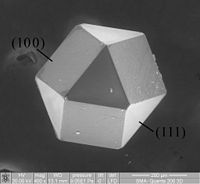
Photo from wikipedia
The primary amine groups on the heptazine-based polymer melon, also known as graphitic carbon nitride (g-C3N4), can be replaced by urea groups using a two-step postsynthetic functionalization. Under simulated sunlight… Click to show full abstract
The primary amine groups on the heptazine-based polymer melon, also known as graphitic carbon nitride (g-C3N4), can be replaced by urea groups using a two-step postsynthetic functionalization. Under simulated sunlight and optimum Pt loading, this urea-functionalized carbon nitride has one of the highest activities among organic and polymeric photocatalysts for hydrogen evolution with methanol as sacrificial donor, reaching an apparent quantum efficiency of 18% and nearly 30 times the hydrogen evolution rate compared to the nonfunctionalized counterpart. In the absence of Pt, the urea-derivatized material evolves hydrogen at a rate over four times that of the nonfunctionalized one. Since “defects” are conventionally accepted to be the active sites in graphitic carbon nitride for photocatalysis, the work here is a demonstrated example of “defect engineering,” where the catalytically relevant defect is inserted rationally for improving the intrinsic, rather than extrinsic, photocatalytic performance. Furthermore, the work provides a retrodictive explanation for the general observation that g-C3N4 prepared from urea performs better than those prepared from dicyandiamide and melamine. In-depth analyses of the spent photocatalysts and computational modeling suggest that inserting the urea group causes a metal-support interaction with the Pt cocatalyst, thus facilitating interfacial charge transfer to the hydrogen evolving centers.
Journal Title: Advanced Energy Materials
Year Published: 2017
Link to full text (if available)
Share on Social Media: Sign Up to like & get
recommendations!